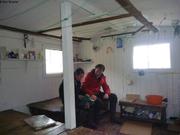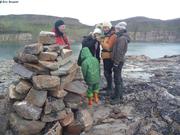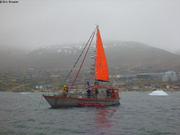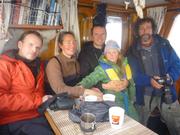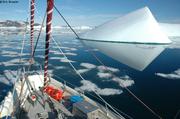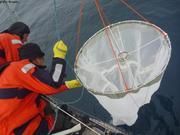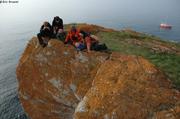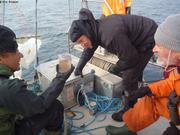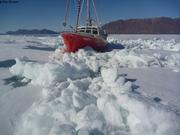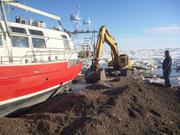After a short stop at Thule Air Base, with Anders, David and Allan, we can
watch them working at Saunders Island. Allan is a climber: using ropes, he is
very quietly going down the cliff and manage to recapture Thick-billed Murres
equipped with geolocators since last year or the year before (to follow
migration and dives). Back to the main study site, a huge little auk colony
(hundred of thousands of birds, not even disturbing two dozens of neighbouring
muskox), we begin a 120 Nautical Miles transect, with 12 stations for plankton
sampling (down to 50m) and CTD cast (down to 500m). Operations are working
well on the rear platform of the boat, everyone is needed because of the
swell.
Just before these two days at sea, the starboard engine broke down... Happily,
Vagabond is having two engines and the survey can go on with one engine, at a
little slower speed. Luckily the weather is fine.
The following week, only David stays on board to survey the numerous sea bird
colonies in Savissivik and Melville Reserve regions. Wonderful trip, from
glassy sea to 40 knots of wind, sailing in fjords with a lot of icebergs and
past winter large ice floes. It is sometimes hard to find a way through! More
than a hundred of Harbour seals are lying in the sun on such a floe... while
two bears are slowly getting closer. We find anchorage late in the evenings,
but we are happy to go ashore in the morning before sailing again. When
crossing an area with a lot of birds, we get a very good sample of Calanus
copepods, the best prey for little auks. Our stop in Savissivik is cold, fog
is heavy, strong wind... sailing for one night in pretty rough conditions is
needed to meet with the rest of the team, coming on board quickly because some
more bad weather is coming.
Back to Saunders Island, Vagabond is standing by near a hunter cabin, while
Anders and Allan are successfully recapturing geolocators from science
selected Thick-billed Murres.
The last station for water and plankton sampling is not easy because the wind
is gusting to 30 knots. Impossible to collect copepods that the team wish to
bring back alive to Denmark! Vagabond then drops anchor in front of the
village of Dundas (abandoned when Thule Air Base was built), a better shelter
than Thule Port. The mission is finished, scientists are happy, it was a great
experience for all of us.
David Boertmann is signing the book he wrote on seabirds of Greenland, given
by David Gremillet in 2005 when doing a similar survey on the East coast of
Greenland.
During our stop, we are getting a great help from friendly and kind Danish and
Greenlandic people working for Thule Air Base (little contact with Americans).
Supplies of all kind, and above all, repair of our starboard engine (thanks to
a spare injection pump given by Yanmar in Japan during our stay in
2003!!).
Léonie and Aurore cannot stop going to the "Fitness center" and to the
"Community center" (games!), and they enjoy a lot the restaurant of the
base... What a change from our daily life!
Strong winds (and snow falls!) are keeping us in Thule for a few more days,
time to check the anchor that has just been fixed! In the end, we reach
Qaanaaq in one day late, ready to take on board Emmanuel Hussenet and his
little team.
